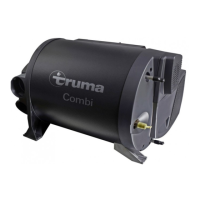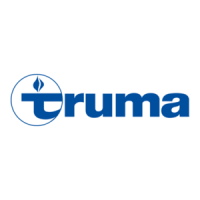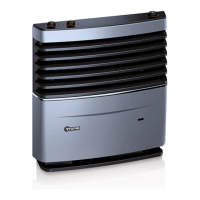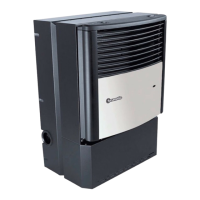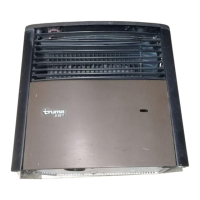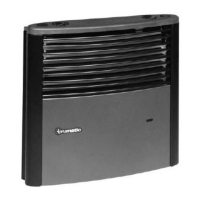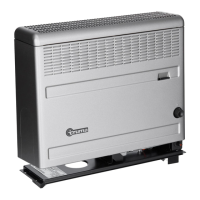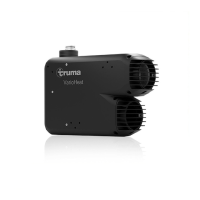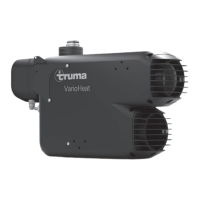7
Always install a new
O-ring following any
disassembly.
Permissible duct
lengths
Fig. A 1: For the wall cowl
the duct lengths can be rout-
ed from min. 70 cm to max.
100 cm as ascending duct in
whichever way required, or
descending by max. 5 cm.
Duct lengths of min. 100 cm
to max. 150 cm must be
ascending at an angle of at
least 45°.
Fig. A 2: Roof cowl duct
lengths of up to max. 230 cm
must be ascending at an
angle of at least 45°.
Connection of the
exhaust double duct
to the appliance
Fig. D: Press end of exhaust
duct (1) together so that win-
ding touches winding. Slide
clamp (4) onto connecting
piece (3) and engage. Slide
clamp (7) over the combus-
tion air supply tube (5). Slide
flue gas pipe (1) over the
O-ring (2) and below the
clamp (4), and tighten clamp
(4). Slide combustion air
supply duct (5) onto the
connecting piece (6) and
secure with clamp (7).
Assembly of wall cowl
Fig. E: Choose a wall which
is as straight as possible and
which is well exposed to
wind from all directions. Drill
an opening of 83 mm diame-
ter (pack wood into any hol-
low spaces in the area of the
cowl opening). Use the en-
closed rubber seal (8) for
sealing. In the event of struc-
tured surfaces coat with plas-
tic body sealant – do not use
silicone!
Slide clamp (7) over the ducts
prior to passing the exhaust
double duct through the
opening.
Slide rubber seal (8) and
clamp (4) on the cowl inner
part (9). Press together end of
exhaust duct (1) so that wind-
ing touches winding, and
slide over O-ring (10) onto the
connection fitting (11 – bend
pointing up).
Engage clamp (4) with hole
on the upper pin (screw
pointing down) and tighten.
Slide combustion air intake
duct (5) on the serrated
connection fitting (12).
Fasten cowl inner part (9) with
6 self-tapping screws (14),
mount cowl outer part (15)
and fasten with 2 screws (16).
Fasten combustion air intake
duct with clamp (7), from the
inside, on the connection
fitting (12).
Fasten cowl double duct to
the wall with at least one
clamp ZRS (17).
Assembly of the
roof cowl
Fig. F: Select a part of the
roof which is as straight as
possible and which is well ex-
posed to wind from all direc-
tions. Drill an opening of
83 mm diameter at a center
distance of at least 65 mm to
the side walls (pack wood in-
to any hollow spaces in the
area of the cowl opening).
Sealing is carried out with
the enclosed rubber seal (20)
without further sealing
compound.
Slide rubber seal (20) on the
cowl part (21). Pass cowl
from above through the roof
and secure with retention
ring (22).
Mount cowl cover (23) and
secure with two screws (24).
The exhaust outlets
(25) must be posi-
tioned crosswise to the direc-
tion of travel, the label
„FRONT“ (26) must be fac-
ing in the direction of travel!
Press together end of ex-
haust duct (1) so that win-
ding touches winding. Slide
clamp (4) onto connecting
piece (28) and engage. Slide
clamp (4) over the combus-
tion air supply tube (5). Slide
flue gas pipe (1) over the
O-ring (27) and below the
clamp (4), and tighten clamp
(4). Slide combustion air
supply duct (5) onto the
connecting piece (29) and
secure with clamp (7).
Fasten cowl double duct to
the wall with at least 3 clamps
ZRS (17).
Fastening the
appliance
Bring appliance into installa-
tion position and, using the
three provided fastening
bolts B 5.5 x 25, ensure the
appliance is firmly connected
to a suitable base (sawn
wooden board, laminated
wooden battens or metal
base).
Warm air distribution
and circulating air
return
Heating air intake vents must
be arranged in such a way
that under normal operating
conditions exhaust gas from
the vehicle engine and heater
appliance cannot enter the in-
side of the vehicle. It must be
ensured by means of con-
struction design that the
heating air introduced into
the vehicle is not polluted
(e.g. by oil vapour). This is
achieved, for example, with
air heaters with circulating air
operation, both for interior
installations and for external
installations. (In heaters with
fresh air operation the fresh
air is not to come from the
engine compartment or from
the vicinity of the exhaust or
the exhaust outlet of the
heater.)
Warm air distribution
Most of the warm air is led
into the floor area of the liv-
ing compartment via flexible
warm air ducts.
The 4 connecting pieces on
the unit are designed for the
65 mm diameter ÜR duct
(Art. no. 40230-00). Only
pressure-proof air ducts that
comply with the Truma quali-
ty standard must be used.
Other ducts that do not meet
our quality standard (particu-
larly with regard to crown
pressure resistance, ducts
diameter and number of
grooves) must not be used.
In order to prevent
heat accumulation
when using the Trumatic
C 6002, all 4 warm air
connecting pieces must be
attached. The cross-section
of the hot air pipes must not
be reduced by pipe connec-
tions or the like.
With the Trumatic C 3402,
all four or only three of the
hot air outlets can be as-
signed. The unassigned hot
air outlet is closed off by
means of the closure cover
VD (Art. no. 40352-00).
The warm air system is de-
signed for each type of vehi-
cle individually, on a modular
basis. There is an extensive
accessories program avail-
able (refer here to our
brochure). You can obtain di-
agrams free of charge from
the Truma Service Centre,
showing optimal installation
suggestions for warm air
systems in all current-type
caravans and mobile homes.
By using the 72 mm
diameter VR duct up to
the respective first air outlet,
the amount of noise is re-
duced. Remove reducing
sleeves from air outlet con-
nections and use U-clamp set
(Art. no. 34000-81800) when
connecting this pipe.
Circulating air return
The circulating air is sucked
in again by the device, either
directly via an aperture mea-
suring about 150 cm
2
from
the living room to the instal-
lation room, or via several
smaller apertures with the
same surface area.
Gas connection
The operating pressure
for the gas supply is
30 mbar (or 28 mbar butane/
37 mbar propane) or 50 mbar
and must correspond to the
operating pressure of the
appliance (see name plate).
The 8 mm diameter gas sup-
ply pipe must be attached to
the connecting piece with a
cutting ring connection. Care-
fully counterhold with anoth-
er spanner when tightening!
The gas connection fitting
on the appliance is not to
be shortened or bent.
Prior to connecting the appli-
ance make sure that the gas
lines are free from dirt, chips
and such!
Route the pipes in such a
way that the appliance can
be removed again for
servicing.
Keep the number of parting
connections in the gas supply
line in rooms frequented
by people to a technically
feasible minimum.
The gas system must accord
with the technical and
administrative provisions
of the individual country of
use (in Europe, for example,
EN 1949 for motor vehicles
or EN ISO 10239 for boats).
National regulations and rul-
ings (in Germany, for exam-
ple, the DVGW worksheet
G 607 for motor vehicles or
G 608 for boats) must be
respected.
